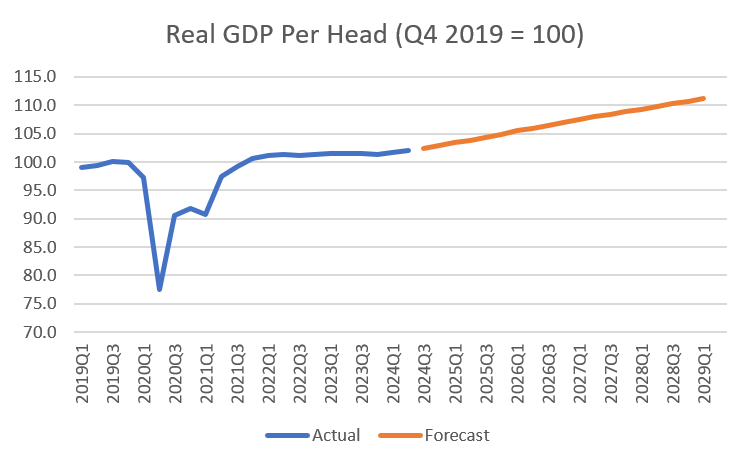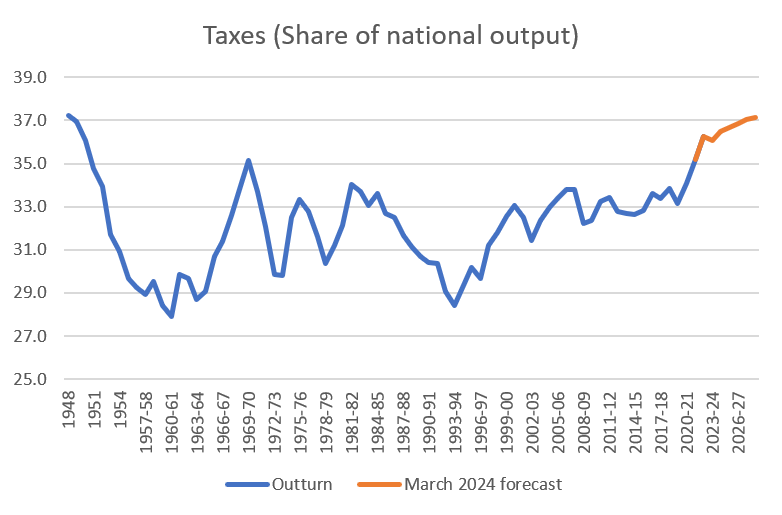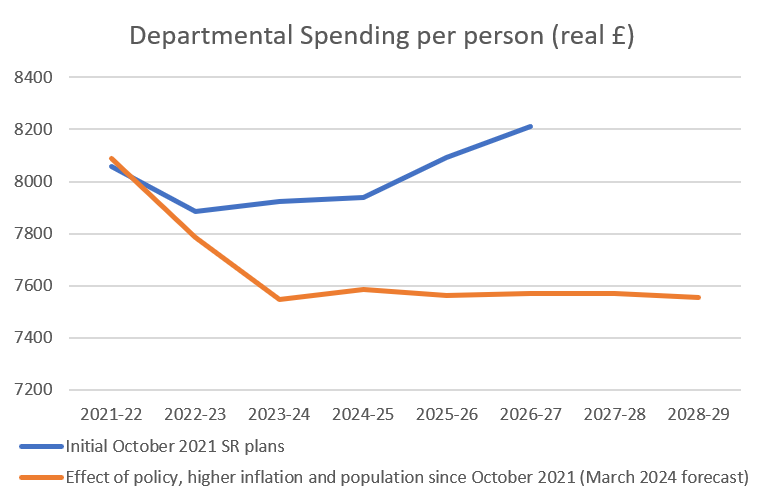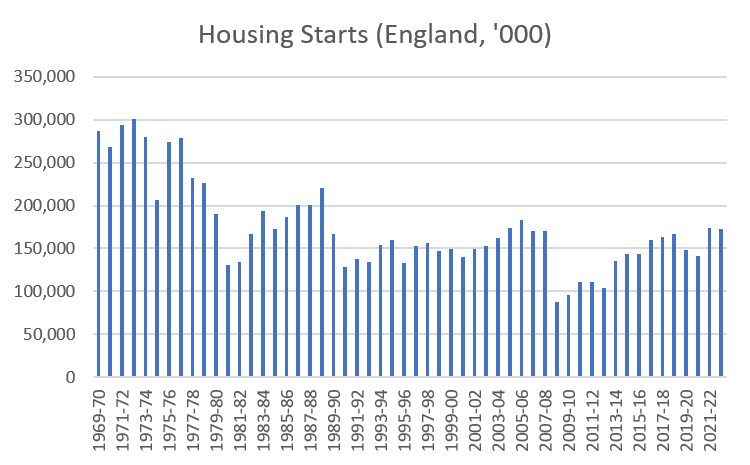SORBUS spotlight: What difference will the election make?
As a general rule of thumb, Spotlight tends to avoid making short-term calls. There is rarely much upside in providing such predictions and there is always the risk that one will end up looking rather silly if one is proved wrong. There is more value in analysing the impact of previous Bank of England rate increases, for example, than speculating on the exact level of policy rates by the end of the year.
This time though it seems safe to make an exception. The Conservative Party will lose the general election due in early July and Labour will form its first British government since 2010. The much more interesting question is whether any of this will have any macroeconomic impact.

Source: SORBUS PARTNERS, OBR (data as at 18/06/2024)
If one wanted to tell the story of the election in one chart, the above would not be a bad starting point. It shows national income per person since the last election and the Office for Budget Responsibility’s forecasts of its likely course over the next five years.
The story is a familiar one: a steep fall during the pandemic, a relatively rapid bounce back as the lockdowns ended and then essentially stagnation since mid-2021. It is hard to win an election when people are not feeling any better off.
Add in the impact of high inflation and a larger tax take (on which more later) and most people are feeling worse off than in 2019.
But whilst the steady recovery expected in the quarters ahead looks good by comparison to the previous few years of stagnation, it still remains challengingly weak.
The big picture is that between 1992 and 2008, the UK experienced the second fastest growth in national income per head amongst the G7 nations, beaten only by the United States. But in the last fifteen years it has experienced the second slowest, ahead of only Italy.
Whilst headline GDP growth has been faster than that of many European peers, that figure has been inflated by much higher levels of immigration. It is income per head which really matters for living standards, consumption and, it seems, winning elections.
One consequence of that slow growth, coupled with rising government debt levels and higher interest bills, has been a sharp rise in the tax level over the past few years.

Source: SORBUS PARTNERS, OBR (data as at 18/06/2024)
Taxes as a share of overall national income are now at their highest level since the 1940s and, on the assumption of no change in policy, are set to drift higher still in the years ahead.
Much of the work is being done by so-called fiscal drag. Income tax thresholds have been frozen rather than being uprated inline with inflation, pulling more workers into paying income tax for the first time or into the 40% tax band.
According to Labour’s manifesto, they have no plans for any major change here. A few specific revenue raisers – VAT on private school fees, a higher windfall levy on energy companies and so on – have been earmarked to fund specific policy pledges but their overall fiscal package is remarkably similar to that of the outgoing government.
They have categorically pledged to not raise VAT, national insurance contributions or income tax rates.
There is though a real question mark over how sustainable this will prove to be in office.
To understand why, it is worth looking in some more detail at what the public finance plans they have signed up to imply in practice.

Source: SORBUS PARTNERS, OBR (data as at 18/06/2024)
The above chart shows government spending, as set out in the 2021 Spending Review, on all government departments (so counts, for example, local government, health, education and police spending) but does not include transfer payments such as welfare and pensions, capital spending or interest payments. It is expressed in monetary terms per person.
Those numbers, first set out three years ago, have been rigidly stuck to by the Conservative government despite higher than expected immigration and considerably higher than expected inflation. The lower line accounts for that higher inflow of people and faster price growth.
Take the fiscal year 2025-26, which begins next year, as an example of what this means in practice. Under the government’s original estimates public service spending per person was supposed to have been £8,094 that year. But on the current numbers it is due to be more like £7,564 – a fall of 6.6%.
It is questionable whether such real levels of public spending (£7,564) would ever have truly been delivered by a Conservative government but it seems almost impossible that they will be by a Labour government.
Even leaving aside Labour’s close ties to trade unions and the fact that a disproportionate share of its membership work in the public sector, the leadership knows that the current poor state of the public realm is one of the major reasons it looks set to win on the 4th July. Improving public sector outcomes will be an important task if it wishes to be re-elected.
All of which implies that the Party will be looking to re-set public spending plans at a higher level in the future to prevent further real terms cuts. That likely means either more tax rises than the Party is currently prepared to say, higher borrowing (which would be a tricky proposition with debt levels where they are and interest rates back at more normal levels) or faster growth.
The Party’s preferred answer is faster growth, which should – in theory – generate the extra revenues needed without touching tax rates. Of course, desiring faster growth and actually generating it are rather different things.
What then is the Party’s plan to boost growth? Until a few years ago it relied on higher levels of public investment spending but that has dropped to avoid spooking voters. Now the plan rests on two assumptions.
The first is rather hard to quantify and is described by the Party as “stability”. The argument is that much of the past eight years has been marked by political uncertainty – Britain has had five Prime Ministers and seven Chancellors since 2016, together with two referendums and now four general elections since 2014. Several policy areas – such as the route to net zero or High Speed rail – have seen frequent U-turns.
Private sector investment has been weak since 2016 and some of this may reflect that heightened uncertainty. In effect, Labour hopes that by being boring they can unlock some previously paused capital spending plans. The hope is that by providing a stable political environment, with higher levels of policy certainty, private sector investment can be increased.
There may be something in this, although putting numbers on it is not exactly a science.
The more material side to the growth plan is planning reform.
Few doubt that Britain’s planning process, as it currently stands, is a mess.

Source: SORBUS PARTNERS, OBR (data as at 18/06/2024)
House building for example has fallen materially short of the government’s 200,000 a year target for years.
The current planning regime essentially gives veto powers over new developments to existing local residents. Changing that is not easy and probably comes with a high political cost.
The losers are likely to care far more than the potential winners, at least in the short term and may extract their vengeance at the ballot box.
Whilst housing tends to be the most emotive part of the policy debate on planning reform, a good case can be made that infrastructure is the bigger deal. Some of the numbers here are genuinely eye-catching. Take, for example, the proposed Lower Thames Crossing, a planned 14 mile road to the east of London needed to relieve congestion on existing bridges and tunnels. Whilst not a single shovel is yet in the ground, it has generated 359,000 pages of planning applications and documents and cost almost £800 million so far.
That is an extreme example but not a unique one. For large scale infrastructure projects the process now takes an average of around five years from application to approval and generates thousands of pages of paperwork.
There is genuine potential economic upside in simplifying this system but it will come with a political cost. Those opposed to housing developments near their homes will be unlikely to welcome roads, wind farms or power stations.
Of course even a radical simplification of the planning system will not yield immediate gains, infrastructure still takes time to build.
This then will be Labour’s challenge if, and this is still an if, it genuinely reforms the planning system and if investors and firms do react to the promise of stability then a reasonable case can be made that economic growth will pick up somewhat. But probably not in a transformative way.
Faster growth will help to balance the books for the government but not by enough to override the planned real terms cuts in spending. So, whatever the Party may now insist, it is safest to expect tax rates to continue climbing.
The economic effects of a Labour victory then are likely to be somewhat faster growth but also a higher tax burden.
|
What we are watching US Labour Market, 5th July – Whilst most Britons will still be digesting the election results, global markets will be turning to the latest US job figures. The labour market remains the single most important determinant of where US interest rates will end the year. China Trade, 8th July – Chinese trade data has been interesting in recent months and is a topic Spotlight will be turning to soon. As the domestic economy has slowed, spare industrial capacity has been turned towards – often lower priced – export markets. With a US election on the horizon this has the potential to intensify oncoming trade disputes. EU Banking Stats, 16th July – Cross EU banking lending stats provide a useful snapshot of economic conditions – and divergence – across the Eurozone. |
